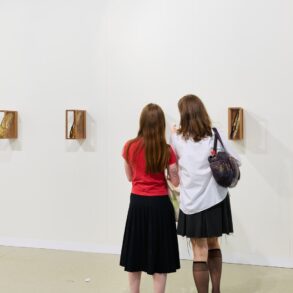Shining Lights: Black Women Photographers in 1980s–90s Britain is the new photo book bringing together the work of trailblazing Black image-makers from the UK
In Britain, the two decades that preceded the millennium were marked by significant social, political and economic shifts. Racked by deindustrialisation, urban uprising and controversial policies, people turned to one another to forge communities and exchange ideas. A prime example of such was the political and artistic mobilisation of Black women’s groups.
Shining Lights: Black Women Photographers in 1980s-90s Britain (co-published by MACK books and Autograph gallery) honours the legacy of the image-makers of the burgeoning Black arts movement; a radical, collective voice and key driving force of the independent creative scene of the 80s and 90s. Joy Gregory, one of the period’s most influential photographic artists, compiles the work of 57 female practitioners alongside historical essays and roundtable conversations that deftly explore the innovative and diverse images that emerged during this time.
The work between the covers of this book was created under the shadow of Thatcher’s Britain which, for many, was brutal and unyielding. “Margaret Thatcher came to power in 1979, denying the existence of class and, in the tradition of her party, casting all immigrants as problematic,” Gregory tells Dazed. “It was a time coloured by profound racism, illustrated by the lack of justice for the New Cross Fire and the murder of Stephen Lawrence as well as uprisings in major cities against ills such as racially motivated police brutality.”
Looking back on her own practice – which primarily focuses on self-identity and beauty culture through auto-portraiture – Gregory explains the pain of remembering the “discouragement, neglect, condescension, and rebuttals” she encountered while trying to pursue a career in her twenties. As the first Black woman to be enrolled on the photography course at the Royal College of Arts, she redressed the blanket erasure of positive images of Black women in the media.
Gregory recalls that the comprehension of ‘Black’ in Britain during this period seemed to be “more of a political identity than a physical one, revolving around the notion of representing oneself as ‘other’”. As such, Shining Lights features work by photographers of varying heritage, whether that be southern Mediterranean, African, Middle Eastern, Latin American, Indian or Eastern European. From Claudine Holmes and Roshini Kempadoo’s shared series of contemplative portraits centring Black subjectivity to Maria Luiza Melo Carvalho’s 1987 exhibition Our Space in Britain, these photographers share in a multi-located vision of Britain.
![Shining Lights [MACK, 2024]](https://artistsocial.network/wp-content/uploads/2024/01/1365247.jpg)
Born out of grassroots darkroom activism, the work – while at times subtle – is inherently polemical. Gregory’s unparalleled anthology examines a gamut of photographic styles ranging from photojournalism and portraiture to travel photography and photomontage. Illuminated by ephemera and archive material, in its comprehensive and egalitarian composition, the book remains in keeping with the spirit of the time, reflecting the plurality of womanhood expressed by its subjects. “I think one of the very important aspects of this book was that it wasn’t about competition or hierarchies, who was the best or who do you like more? It was about being there and being a support to others,” says Gregory.
The variety of practices also narrates the radical impact of the burgeoning digital age during this period. This is evidenced throughout the book by the analogue practices of Chila Kumari Burman with her photo-etchings, Veena Stephenson’s sculptural installation and AnnetteSylvester’s film-based superimpositions, moving through to the tape-slide productions of Amina Patel and Laxmi Jamdagni or the digital collages of Roshini Kempadoo and Anita Jenni Mckenzie.
![Shining Lights [MACK, 2024]](https://artistsocial.network/wp-content/uploads/2024/01/1365250.jpg)
Largely overlooked by established institutions, publishers and art dealers, Gregory and the women of Shining Lights embodied a spirit of self-organisation and community, safeguarding creative identities by curating their own exhibitions, events, and publications. “While there were small pockets of support within the Arts Council, the primary bolster, especially in London, came from the Greater London Council,” recalls Gregory. “Its decline during this period marked a significant downturn in opportunities and support for many to sustain their artistic practices. Due to the inhospitality of mainstream institutions, we had to forge our own spaces which is precisely why venues like Autograph, InIva, 198 Gallery, the Black Art Gallery, and Brixton Art Gallery emerged.”
Shining Lights is an impressive paean to those pioneering women who came before and created a myriad of magical images against a backdrop of social and political turbulence. “I’ve always maintained that photography is a much broader subject than people often give it credit. Sometimes it sits on the edge of printmaking, sometimes on the edge of filmmaking but in all cases, it’s about telling stories,” Gregory concludes. “This book is a starting point rather than an end, and I very much hope that someone else takes up the batten.”
Shining Lights: Black Women Photographers in 1980s-90s Britain is co-published by Autograph and MACK and is available to purchase here.
This post was originally published on this site be sure to check out more of their content








